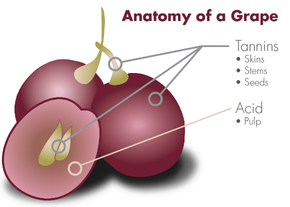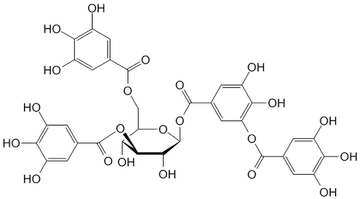The Difference You Need To Know Between Tannin And Acid
 Working in the tasting room at Yao Family Wines in St. Helena, perhaps the second most common question we receive from both beginners and experts alike is, “what's the difference between tannin and acid?” (the first most common is, “How tall is Yao Ming?”). This is a critical question, as the two can be quite easily confused. Let’s shed a little more light on the subject.
Working in the tasting room at Yao Family Wines in St. Helena, perhaps the second most common question we receive from both beginners and experts alike is, “what's the difference between tannin and acid?” (the first most common is, “How tall is Yao Ming?”). This is a critical question, as the two can be quite easily confused. Let’s shed a little more light on the subject.
First, let’s take a closer look at tannin. Tannin is a naturally-occurring phenolic compound, found in the skins, seeds and stems of a grape. It can also be added to a wine through aging in an oak barrel. Phenols typically add a flavor of astringency and bitterness to a wine, which may sound awful, but that same quality is what gives a wine balance, structure and complexity, allowing it to age longer. Best of all, tannins provide the antioxidants in wine that have all the health benefits. Although these phenolic compounds are found in all wines in various amounts, we usually associate tannins with red wines, as the juice has extended contact with the phenol-rich skins, stems and seeds during fermentation.

Tannin is often confused with "dryness" because tannin imparts a dry feeling in your mouth. Dry, however, is a wine term used to denote the level of sweetness in the wine. Again, it's the astringency that creates the feeling of your cheeks being sucked in and themoisture evaporating from your mouth. This is one of the most primary characteristics of tannin.
Acid, on the other hand, is what gives wine it’s refreshing, flavorful sensation. Acidity is apparent in all fruit, be it grapes, lemons or tomatoes (yes, tomatoes are a fruit). Grapes start out as being entirely acidic, and as they develop the acid turns into sugar. Harvesting grapes at a key balance point between sugar and acid is critical, as is allowing the sugar to convert to alcohol in the fermentation process so the acid is lively and predominant. Too little acid and the wine can seem flabby and lifeless. Too much acid and the wine will be harsh and undrinkable. Acid is also determined by the climate in which the grapes were grown as well as the soil type and physiology of the grape itself. Higher acidity denotes a wine from a cooler region, such as Northern France. Lower acid wines come from countries with warmer weather, such as parts of Australia.
The primary types of acid that are key to winemaking are tartaric, malic and citric. Perhaps the most important element of acid management in winemaking is Malolactic Fermentation. Also called malo, this is a secondary fermentation that converts the tangy and harsh malic acids into creamier and softer lactic acids. When you think of the buttery characteristics of a Chardonnay, for example, this is because the wine has undergone malo to create a rounder mouth feel.
Tasting the Difference Between Tannin and Acid:
Tannins taste bitter on the front-inside of your mouth and along the side of your tongue; Acid tastes tart and zesty on the front of your tongue and along the sides.
Acid makes your mouth feel wet; Tannin makes your tongue feel dry.
With tannins, you feel a lingering bitter/dry feeling in your mouth after you swallow; With acid, your tongue feels gravelly against the roof of your mouth. Acid can also activate the saliva glands underneath your tongue.
Here's a fun way to explore the difference between tannin and acid. Get yourself two bottles of red wine. The first should be a big, bold Napa Cabernet, and the second should be an Italian red like a Valpolicella or Chianti (avoid hearty italians like Super Tuscans and Sangiovese). Taste them side-by-side, trying the Italian wine first. You'll notice with the Chianti a certain kind of effervescence in the wine. This is the lively acid inherent in Chiantis. The Napa Cab, on the other hand, will probably suck all the moisture from your mouth. This is the tannin in action.
So what did you think, tasting those side-by-side? Leave us a comment below and let us know!
